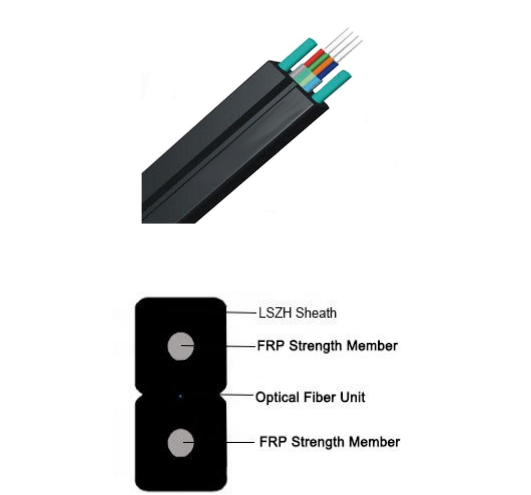FTTH optical fiber drop cable-indoor and outdoor applications
Fiber to the Home (FTTH) has gained popularity in recent years as an access method that provides high-speed Internet access. It can realize high-speed and long-distance transmissions from central points to individual buildings such as apartment buildings, apartment buildings and companies through the installation and use of optical fibers. The FTTH spur cable plays a key role here. So what is an FTTH drop cable? And how do I install it? This article will give you satisfactory answers.
Via FTTH branch cable
The FTTH stub cable contains 1 to 4 singlemode fibers with 250 μm color, which offer a good solution for the last mile solution of fiber-to-the-home. The cable contains two reinforcements made of glass fiber reinforced plastic (FRP) and a low-smoke (LSZH) jacket with a nominal size of 2 x 3 mm. They are fully RoHS compliant. Its small diameter, its low weight and its special structure make it easier to handle, manipulate and pull the fiber optic cable out of the fiber optic cable. It is ideal for installation directly in the house.
Features and Benefits
Choice of fiber type
Individually colored fibers
Notched 2 x 3 mm structure for easy peeling
Singlemode fiber according to ITU-T G.657A1 or ITU-T G.657A2 standard
How to Choose a Suitable LSZH Jacket ?
You have the choice between a white LSZH jacket for indoor use and a black LSZH jacket for short-distance outdoor use. White cables that can be laid in direct sunlight for a long time must be replaced more frequently. Therefore, we have to choose blackLSZH jacket as they are UV-resistant.

Indoor and outdoor applications
There are three main uses for FTTH drop cables: internal FTTH application tiers and risers that clip onto surfaces including baseboards, and brief external use of black low smoke halogen free jackets. For reasons of time and space, this article mainly presents the internal level and riser cabling of FTTH applications, which attach great importance to FTTH cabling.
Horizontal wiring
The branch cables for fiber optic to house applications (FTTH or FTTx) are all dielectric, which means that we need cable ducts in the building. The catheter can be made of metal tubing or rigid polyvinyl chloride plastic. The conduction path should be limited to 100 feet and the bend between pull points or boxes should not exceed two 90 degrees. It can run under the ceiling or wall or the floor.
To attach FTTH fiber optic cables to the optical cable, we need a cable box. They are installed to save the cable and wrap it in the next section of pipe. The cable box is not used to splice cables. To facilitate installation, fish tabs or pull cords should always be placed in the conduit. The inner tube is a great tool for protecting cables and simplifying future installations.
Riser wiring
Vertical drop cables are assigned a calculated maximum vertical slope value. Vertical slope is the distance the cable can be pulled vertically before it is supported. It is determined by the weight of the cable and its resistance to kinking or kinking.
To pull the cable vertically, you can use a separate wire mesh clamp. The device works like a basket or finger clamp, supporting the cable without crushing the core wire. The cables should be supported in the connection cabinet with cable ties, cable ties or clamps. If possible, start from the top and let the weight of the cable pull instead of adding more load.
Finally,FTTH is dramatically increasing the connection speed available to computer users in unprecedented ways. FTTH drop cable is a special optical cable that offers a perfect solution for FTTH transmission.
Contact: Andy Huang
Phone: 0086-755-89239407
E-mail: sales@beskco.com
Add: No.3106,Longgang Avenue,Pidi Town, Longgang District, Shenzhen China
We chat